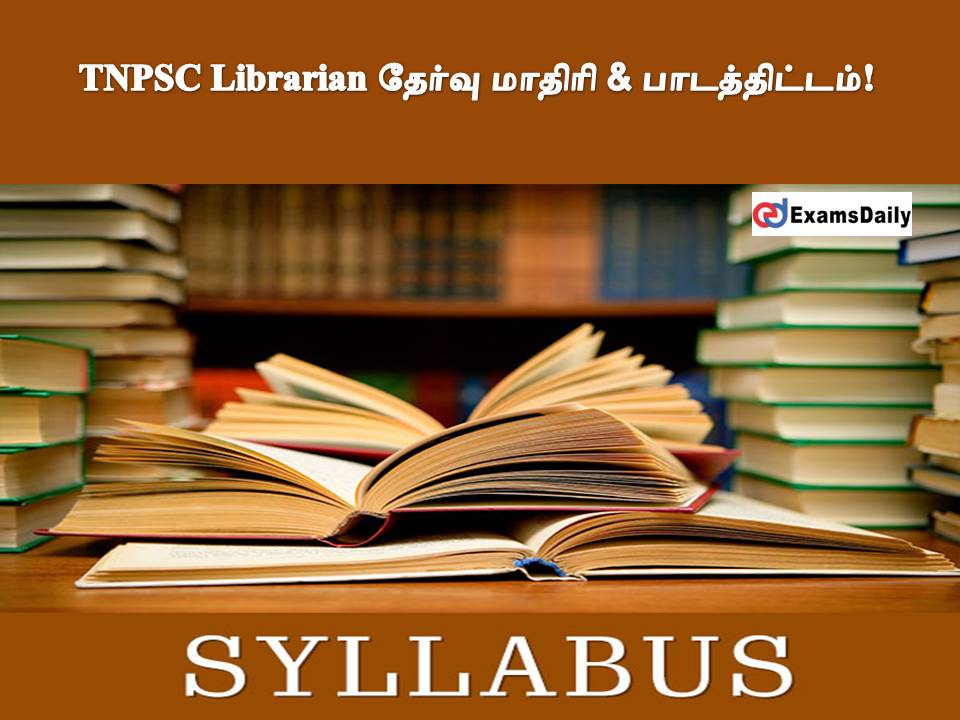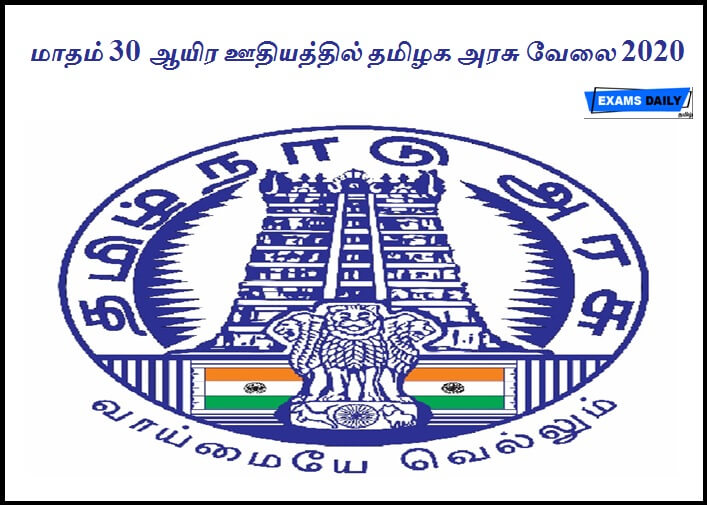TNPSC Librarian தேர்வு மாதிரி & பாடத்திட்டம்!
தமிழ்நாடு அரசு பணியாளர் தேர்வாணையம் நடத்தும் Combined Library State/ Subordinate Services தேர்விற்கான தேர்வு மாதிரி மற்றும் பாடத்திட்டத்தை இந்த பதிவில் காணலாம்.
TNPSC Librarian Notification 2023 Pdf
TNPSC Librarian (Interview posts) தேர்வு மாதிரி:
| Subject Examination in OMR/Computer Based Test Method | Duration | Maximum Marks | Minimum qualifying marks for selection | |
| SCs, SC(A)s, STs, MBCs/ DCs, BC(OBCM)s & BCMs | Others | |||
| Paper-I (Subject Paper) (200 Questions) Library and Information Science (P.G Degree Standard) (Code No. 267) | 3 Hours | 300 | 153 | 204 |
| Paper II (Objective Type) Part-A Tamil Eligibility Test (SSLC Std) (100 questions/ 150 marks) | 1 ½ Hours | Note:
Minimum qualifying marks– 60 marks (40% of 150) Marks secured in Part-A of Paper-II will not be taken into account for ranking. |
||
| Part-B (General Studies)(Code No.003) (100 questions/ 150 marks) General Studies (Degree Std) – 75 questions and Aptitude & Mental Ability Test (SSLC Std.) -25 questions | 1 ½ Hours | 150 | ||
| (iii) Interview and Records | 60 | |||
| Total | 510 | |||
TNPSC Librarian (Non- Interview posts) தேர்வு மாதிரி:
| Subject Examination in Computer Based Test Method | Duration | Maximum Marks | Minimum qualifying marks for selection | |
| SCs, SC(A)s, STs, MBCs/ DCs, BC(OBCM)s & BCMs | Others | |||
| (i) Paper I (Objective Type) Subject Paper (200 Questions) Library and Information Science (B.L.I.S) (Degree Standard) (Code No. 266) | 3 Hours | 300 | 135 | 180 |
| (ii) Paper II (Objective Type) (200 Questions) Part-A Tamil Eligibility Test (SSLC Std) (100 questions/ 150 marks) | 1 ½ Hours | Note:
|
||
| Part-B (General Studies)(Code No.003) (100 questions/ 150 marks) General Studies (Degree Std) – 75 questions and Aptitude & Mental Ability Test (SSLC Std.) -25 questions | 1 ½ Hours | 150 | ||
| Total | 450 | |||
LIBRARY AND INFORMATION SCIENCE (B.L.I.S) (DEGREE STANDARD) Objective type:
UNIT-I: LIBRARY AND SOCIETY
- Library as a Social Institution; Impact of Libraries on Social, Political, Economical, and Cultural aspects, Laws of Library Science.
- Types of Libraries – Public, Academic and Special Libraries; Library movement in India;
- Library Legislation; Public Library Act; Delivery of Books and Newspapers (Public Library) Act; Intellectual Property Rights – Copyright Act.
- Library associations and Professional bodies – UNESCO, IFLA, ALA; CILIP; ILA;IATLIS.
- Role of government agencies in library development RRRLF;UGC-INFLIBNET.
UNIT –II: LIBRARY MANAGEMENT:
- Management – Concept; Definition; School of Thoughts – Functions of Management; (POSDCORB); Library Authority and Committee.
- Library Sections and Routines – Acquisition, Technical, Maintenance,Circulation, Reference and Periodical.
- Human Resource Management – Job Analysis, Job Description, Recruitment,Selection, Training, performance Appraisal, training, motivation, etc.
- Financial Management– Budget – Types, Sources of income to various types of libraries, Physical facilities – Building and Furniture.
- Library Records – Statistics; Reports.
UNIT-III: INFORMATION PROCESSING (LIBRARY CLASSIFICATION)
- Library Classification – Concept; Definition; Need and Purpose.
- Library Classification – Types: General and Special; Various Schemes of classification – Colon Classification; Dewey Decimal Classification; Universal Decimal Classification and Library of Congress Classification.
- Structure of knowledge – Modes of Formation of Subject, – Canons and Laws.
- Facet and Facet analysis – Fundamental categories (PMEST); Analytico Synthetic approach and Devices. (v) Notation – Types; Characteristics.
UNIT- IV: INFORMATION PROCESSING (LIBRARY CATALOGUING)
- Library Cataloguing – Concept; Definition; Need, Purpose and Functions.
- Library Catalogue – Types – Physical forms and Inner forms – Alphabetical, Classified, and Alphabetico-Classified; Trade catalogue;
- Cataloguing Standards – ISBDs; Cataloguing Codes – Classified CatalogueCode of Ranganathan, Anglo-American Cataloguing Rules
- International Standards – MARC – CCF; UNIMARC; MARC21; Metadata
- Subject Headings – Sears‟ List of Subject Headings, LCSH, Centralised and CoOperative Cataloguing.
UNIT – V: – INFORMATION SOURCES
- Information Sources – Types – primary, secondary, and tertiary; Print Vs. Electronic resources; Human Vs. Institutional
- Evaluation of Information Sources – Criteria
- Secondary Sources: Dictionaries, Encyclopedias, Indexing and Abstracting Sources, Directories, Biographical Sources; Geographical Sources
- Electronic Information Sources – Databases; Full-text databases
- Information Sources – Discipline-oriented sources – Pubmed; INSPEC; etc; UGC- e-Sadhsindhu Open sources
UNIT – VI:- INFORMATION SERVICES
- Information Services – Types: Ready reference and Long range reference services; User education; Information literacy
- Literature search – Bibliography compilation and Bibliographical services
- Current Awareness Service, SDI
- Indexing and Abstracting services; Referral Service.
- Reprography, Translation and other specialized services
UNIT – VII:- COMPUTER AND COMPUTER APPLICATIONS
- Computer – Definition; Characteristics; Classification of Computers Hardware – Generations; Input and Output Devices; Secondary Storage Devices; Telecommunication – Concept and Components.
- Computer Software – Meaning; Types – System Software and Application Software; Operating System – Single user vs. Multi-user; Open Sources vs Proprietary
- Database – Concept; Database Management System (DBMS) – Concepts; Functions;
- Library Automation – Need and Purpose; Areas of library automation; Library automation software packages – Proprietary vs. Open.
- Web Technology – Browser, Search Engine, Protocol, ISDN.
UNIT- VIII: – RESOURCE SHARING AND NETWORKING
- Resource sharing – Concept, Definition, Need, Purpose.
- Library Co-operation – Concept, Definition, Need and Purpose.
- Computer Networks – Types – LAN, WAN, MAN; Internet and Intranet
- Library Networks – Concept, Need, Functions.
- Library Network System – International, OCLC Worldcat; National –INFLIBNET, DELNET.
PAPER – II SYLLABUS FOR WRITTEN EXAMINATION
Part-A கட்டாய தமிழ்மொழி தகுதித் தேர்விற்கான பாடத்திட்டம் (கொள்குறி வினாவிற்கான தலைப்புகள்) பத்தாம் வகுப்பு தரம்
1. பிரித்தெழுதுதல் / சேர்த்தெழுதுதல்.
- எதிர்ச்சொல்லை எடுத்தெழுதுதல்.
- பொருந்தாச் சொல்லைக்கண்டறிதல்.
- பிழைதிருத்தம் (i) சந்திப்பிழையை நீக்குதல் (ii)மரபுப்பிழைகள், வழுவுச் சொற்களை நீக்குதல் / பிறமொழிச்சொற்களை நீக்குதல்.
- ஆங்கிலச் சொல்லுக்கு நேரான தமிழ்ச்சொல்லை அறிதல்.
- ஒலி மற்றும் பொருள் வேறுபாடறிந்து சரியான பொருளையறிதல்.
- ஒரு பொருள் தரும் பல சொற்கள்.
- வேர்ச்சொல்லைத் தேர்வு செய்தல்.
- வேர்ச்சொல்லைக் கொடுத்து / வினைமுற்று, வினையெச்சம், வினையாலணையும் பெயர், தொழிற்பெயரை / உருவாக்கல். 10. அகரவரிசைப்படி சொற்களை சீர் செய்தல்.
- சொற்களை ஒழுங்குப்படுத்தி சொற்றொடராக்குதல்.
- இருவினைகளின் பொருள் வேறுபாடு அறிதல். (எ.கா.) குவிந்து-குவித்து
- விடைக்கேற்ற வினாவைத் தேர்ந்தெடுத்தல்.
- எவ்வகை வாக்கியம் எனக் கண்டெழுதுதல் – தன்வினை, பிறவினை, செய்வினை, செயப்பாட்டு வினை வாக்கியங்களைக்கண்டெழுதுதல்.
- உவமையால் விளக்கப்பெறும் பொருத்தமான பொருளைத் தேர்ந்தெழுதுதல்
- அனுவல் சார்ந்த சொற்கள் (கலைச்சொல்)
- விடைவகைகள்.
- பிறமொழிச் சொற்களுக்கு இணையான தமிழ்ச் சொற்களைக் கண்டறிதல் (எ.கா.) கோல்டு பிஸ்கட் – தங்கக்கட்டி.
- ஊர்ப்பெயர்களின் மரூஉவை எழுதுக (எ.கா.) தஞ்சாவூர் – தஞ்சை
- நிறுத்தற்குறிகளை அறிதல்.
- பேச்சுவழக்கு, எழுத்துவழக்கு (வாரான் – வருகிறான்).
- சொற்களை இணைத்து புதிய சொல் உருவாக்கல்.
- பொருத்தமான காலம் அமைத்தல்
(இறந்தகாலம், நிகழ்காலம், எதிர்காலம்). - சரியான வினாச்சொல்லைத் தேர்ந்தெடு.
- சரியான இணைப்புச் சொல்
(எனவே, ஏனெனில், ஆகையால், அதனால், அதுபோல). - அடைப்புக்குள் உள்ள சொல்லைத் தகுந்த இடத்தில் சேர்க்க.
- இருபொருள் தருக.
- குறில் – நெடில் மாற்றம், பொருள் வேறுபாடு
- கூற்று, காரணம் – சரியா? தவறா?
- கலைச்சொற்களை அறிதல்(எ.கா. – Artificial Intelligence – செயற்கைநுண்ணறிவு, Super Computer – மீத்திறன் கணினி)
- அகரவரிசைப்படி சொற்களை சீர் செய்தல்
- பொருத்தமான பொருளைத் தெரிவு செய்தல்
- சொற்களின் கூட்டுப் பெயர்கள் (எ.கா.) புல் -புற்கள்
- சரியான தொடரைத் தேர்ந்தெடுத்தல்
- பிழைதிருத்துதல் (ஒரு-ஓர்)
- சொல் – பொருள் – பொருத்துக – கெர்
- ஒருமை பன்மையிழை
- பத்தியிலிருந்து வினாவிற்கான சரியான விடையைத் தேர்ந்தெடு.
மேலும் விரிவான பாடத்திட்டங்களுக்கு கீழே வழங்கி உள்ள இணைய முகவரியை அணுகவும்.
Download Syllabus 2023 PDF







